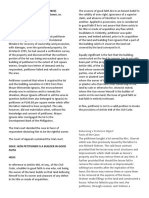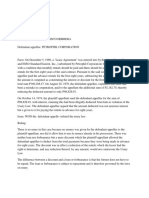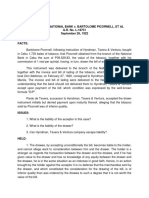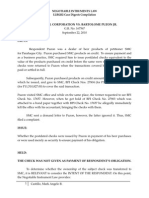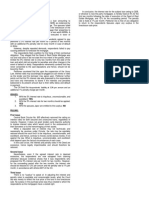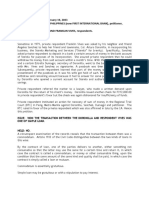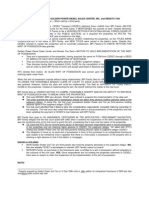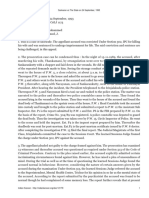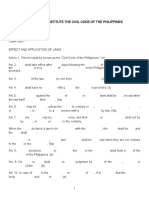Mina Vs Pascual
Mina Vs Pascual
Uploaded by
Kitem Kadatuan Jr.Copyright:
Available Formats
Mina Vs Pascual
Mina Vs Pascual
Uploaded by
Kitem Kadatuan Jr.Original Description:
Original Title
Copyright
Available Formats
Share this document
Did you find this document useful?
Is this content inappropriate?
Copyright:
Available Formats
Mina Vs Pascual
Mina Vs Pascual
Uploaded by
Kitem Kadatuan Jr.Copyright:
Available Formats
Mina vs Pascual
Facts: Francisco Fontanilla and Andres Fontanilla were brothers. Francisco Fontanilla acquired during
his lifetime, on March 12, 1874, a lot.
Andres Fontanilla, with the consent of his brother Francisco, erected a warehouse on a part of the said lot,
embracing 14 meters of its frontage by 11 meters of its depth.
Francisco Fontanilla, the former owner of the lot, being dead, the herein plaintiffs, Alejandro Mina, et al.,
were recognized without discussion as his heirs.
Andres Fontanilla, the former owner of the warehouse, also having died, the children of Ruperta Pascual
were recognized, though it is not said how, and consequently are entitled to the said building, or rather, as
Ruperta Pascual herself stated, to only six-sevenths of one-half of it, the other half belonging, as it
appears, to the plaintiffs themselves, and the remaining one-seventh of the first one-half to the children of
one of the plaintiffs, Elena de Villanueva.
Ruperta Pascual, as the guardian of her minor children, the herein defendants, petitioned the Curt of
First Instance of Ilocos Norte for authorization to sell "the six-sevenths of the one-half of the warehouse,
of 14 by 11 meters, together with its lot.
The warehouse, together with the lot on which it stands, was sold to Cu Joco, the other defendant in
this case
Issue: WoN there exist a contract of commodatum
Held: although both litigating parties may have agreed in their idea of the commodatum, on account of
its not being, as indeed it is not, a question of fact but of law
Contracts are not to be interpreted in conformity with the name that the parties thereto agree to give
them, but must be construed, duly considering their constitutive elements, as they are defined and
denominated by law.
By the contract of loan, one of the parties delivers to the other, either anything not perishable, in order
that the latter may use it during the certain period and return it to the former, in which case it is called
commodatum
It is, therefore, an essential feature of the commodatum that the use of the thing belonging to
another shall BE for a certain period. Francisco Fontanilla did not fix any definite period or time during
which Andres Fontanilla could have the use of the lot whereon the latter was to erect a stone
warehouse of considerable value, and so it is that for the past thirty years of the lot has been used by
both Andres and his successors in interest.
It would seem that the Supreme Court failed to consider the possibility of a contract of precardium
between Francisco and Andres. Precardium is a kind of commodatum wherein the bailor may demand
the object at will if the contract does not stipulate a period or use to which the thing is devoted.
You might also like
- Naguiat Vs CA - Case DigestDocument2 pagesNaguiat Vs CA - Case DigestmansikiaboNo ratings yet
- Producers Bank of The Philippines Vs CADocument2 pagesProducers Bank of The Philippines Vs CAMac100% (1)
- Zobel v. CADocument3 pagesZobel v. CAPio MathayNo ratings yet
- Digest Property NotesDocument9 pagesDigest Property NotesI.G. Mingo MulaNo ratings yet
- Mina, Et Al. v. Pascual, Et Al.Document3 pagesMina, Et Al. v. Pascual, Et Al.Bibi Jumpol0% (1)
- Catholic Vicar Apostolic V CA 165 Scra 515Document4 pagesCatholic Vicar Apostolic V CA 165 Scra 515Aleks OpsNo ratings yet
- Herrera vs. Petrophil (Digest)Document2 pagesHerrera vs. Petrophil (Digest)Rochelle Ann ReyesNo ratings yet
- Nego Conso DigestsDocument50 pagesNego Conso DigestsJCapsky100% (1)
- Yang V CA GR No. 138074Document1 pageYang V CA GR No. 138074Rhuejane Gay MaquilingNo ratings yet
- Us v. IgpuaraDocument4 pagesUs v. IgpuaraMarlon SevillaNo ratings yet
- Firestone Tire & Rubber Co. of The Phils. VS., Court of Appeals, Et. Al., G.R. No. 113236, March 5, 2001Document3 pagesFirestone Tire & Rubber Co. of The Phils. VS., Court of Appeals, Et. Al., G.R. No. 113236, March 5, 2001JANE MARIE DOROMALNo ratings yet
- Gavieres V Pardo de Tavera - DepositDocument2 pagesGavieres V Pardo de Tavera - DepositAnonymous srweUXnClcNo ratings yet
- Republic V FNCBDocument6 pagesRepublic V FNCBMp Cas100% (1)
- Yau Chu V CADocument1 pageYau Chu V CAJaz SumalinogNo ratings yet
- Nil Case DigestsDocument83 pagesNil Case DigestsCha100% (2)
- 04 Security Bank vs. RTCDocument1 page04 Security Bank vs. RTCNichole LanuzaNo ratings yet
- CD 6. Abubakar v. Auditor GeneralDocument1 pageCD 6. Abubakar v. Auditor GeneralAlyssa Alee Angeles JacintoNo ratings yet
- Case Digest Tolentino vs. GonzalesDocument2 pagesCase Digest Tolentino vs. GonzalesDiane Dee Yanee75% (4)
- G.R. No. L-16106 December 30, 1961Document1 pageG.R. No. L-16106 December 30, 1961Mildred Donaire Cañoneo-ClemeniaNo ratings yet
- Consolidated Plywood vs. IFC LeasingDocument3 pagesConsolidated Plywood vs. IFC LeasingNadine Abenoja100% (1)
- PNB v. PicornellDocument3 pagesPNB v. PicornellJurico AlonzoNo ratings yet
- Case Digest Acme Shoe Rubber and Plastic Corp. vs. CADocument2 pagesCase Digest Acme Shoe Rubber and Plastic Corp. vs. CADiane Dee YaneeNo ratings yet
- Casa Filipina Devt Corp VS Deputy Exec SecretaryDocument2 pagesCasa Filipina Devt Corp VS Deputy Exec Secretaryhanabi_13No ratings yet
- Quintos V Beck-DigestDocument2 pagesQuintos V Beck-DigestTricia Sibal100% (1)
- Credit Transactions DigestsDocument3 pagesCredit Transactions Digestshanabi_13No ratings yet
- Tolentino V Gonzales Sy ChiamDocument7 pagesTolentino V Gonzales Sy ChiamJason CabreraNo ratings yet
- San Miguel Corporation vs. Bartolome Puzon Jr.Document2 pagesSan Miguel Corporation vs. Bartolome Puzon Jr.RavenFoxNo ratings yet
- Prudential Bank v. Martinez - DigestDocument3 pagesPrudential Bank v. Martinez - DigestcinfloNo ratings yet
- Quintos Vs BeckDocument1 pageQuintos Vs BeckKitem Kadatuan Jr.100% (1)
- CENTRAL BANK OF THE PHIL. Vs MORFE G.R. NO. L-38427Document2 pagesCENTRAL BANK OF THE PHIL. Vs MORFE G.R. NO. L-38427rengieNo ratings yet
- Commodatum 1. Herrera vs. Petrophil Corporation, 146 SCRA 385 (1986)Document50 pagesCommodatum 1. Herrera vs. Petrophil Corporation, 146 SCRA 385 (1986)Jeorge Ryan MangubatNo ratings yet
- PNB VS CaDocument2 pagesPNB VS CaaxvxxnNo ratings yet
- Astro Electronics Corp Vs PhilguaranteeDocument2 pagesAstro Electronics Corp Vs Philguaranteeadonis.orillaNo ratings yet
- Dio vs. JaporDocument1 pageDio vs. Japor001nooneNo ratings yet
- CASE DIGESTS - Guaranty and SuretyshipDocument5 pagesCASE DIGESTS - Guaranty and SuretyshipAnonymous b4ycWuoIcNo ratings yet
- Garcia v. Thio (G.R. No. 154878, March 16, 2007)Document3 pagesGarcia v. Thio (G.R. No. 154878, March 16, 2007)Lorie Jean UdarbeNo ratings yet
- G.R. No. 133632Document1 pageG.R. No. 133632Sherwin Delfin CincoNo ratings yet
- Case DigestDocument16 pagesCase DigestRaphael Fernand Martinez100% (1)
- Samonte Vs CA PDFDocument6 pagesSamonte Vs CA PDFEnzoNo ratings yet
- YHT Realty Corporation Et Al vs. CA DigestDocument1 pageYHT Realty Corporation Et Al vs. CA DigestChristia Sandee SuanNo ratings yet
- CATHOLIC VICAR APOSTOLIC OF THE MOUNTAIN PROVINCE Vs CADocument2 pagesCATHOLIC VICAR APOSTOLIC OF THE MOUNTAIN PROVINCE Vs CAmark anthony mansuetoNo ratings yet
- BPI Family Bank V FrancoDocument2 pagesBPI Family Bank V FrancoPhilip SuplicoNo ratings yet
- Philippine National BankDocument2 pagesPhilippine National BankCandelaria QuezonNo ratings yet
- Credit Trans DigestDocument103 pagesCredit Trans DigestJunnel Gonzales Jr.No ratings yet
- 13 - de Los Santos vs. Jarra, G.R. No. 4150, 10 February 1910Document2 pages13 - de Los Santos vs. Jarra, G.R. No. 4150, 10 February 1910Bibi Jumpol100% (2)
- Town and Country v. QuisumbingDocument1 pageTown and Country v. QuisumbingJohney DoeNo ratings yet
- Francisco Vs CA NEGODocument3 pagesFrancisco Vs CA NEGOMary LouiseNo ratings yet
- Colito Pajuyo vs. CA (DIGEST)Document2 pagesColito Pajuyo vs. CA (DIGEST)Iron Feathers100% (1)
- Case Digest On NegoDocument9 pagesCase Digest On NegoCayen Cervancia CabiguenNo ratings yet
- Producers Bank Vs CA - DigestDocument2 pagesProducers Bank Vs CA - DigestRengie Galo100% (2)
- Nyco Sales Corp Vs BA Finance Corp (GR No. 71694)Document2 pagesNyco Sales Corp Vs BA Finance Corp (GR No. 71694)KM SurtidaNo ratings yet
- Deposit Cases Digests (BPI Vs IAC To Consolidated Terminals vs. Artex Development)Document11 pagesDeposit Cases Digests (BPI Vs IAC To Consolidated Terminals vs. Artex Development)Ron QuintoNo ratings yet
- Case Digest CREDIT TRANSACTIONS FINALSDocument22 pagesCase Digest CREDIT TRANSACTIONS FINALSLatrell Marcus100% (1)
- PNB V PicornellDocument2 pagesPNB V PicornellJassy Bustamante100% (3)
- de La Victoria Vs Burgos 245 Scra 374Document10 pagesde La Victoria Vs Burgos 245 Scra 374Mp CasNo ratings yet
- BPI Family Savings Bank v. Golden Power Diesel Sales CenterDocument2 pagesBPI Family Savings Bank v. Golden Power Diesel Sales Centertemporiari100% (1)
- Bayani v. PeopleDocument1 pageBayani v. PeopleRenzoSantosNo ratings yet
- Supreme Court: CIR v. Burroughs Limited G.R. No. L-66653Document4 pagesSupreme Court: CIR v. Burroughs Limited G.R. No. L-66653Jopan SJNo ratings yet
- Casabuena vs. CADocument3 pagesCasabuena vs. CAThoughts and More ThoughtsNo ratings yet
- Salas Vs CADocument4 pagesSalas Vs CAHiroshi Carlos100% (2)
- Mina Vs PascualDocument1 pageMina Vs PascualKenJoNo ratings yet
- Motion To ExpungeDocument2 pagesMotion To ExpungeKitem Kadatuan Jr.100% (1)
- Financial Liberalization of The Domestic EconomyDocument4 pagesFinancial Liberalization of The Domestic EconomyKitem Kadatuan Jr.No ratings yet
- San Sebastian College-Recoletos Manila: Remedial Law Review 2Document1 pageSan Sebastian College-Recoletos Manila: Remedial Law Review 2Kitem Kadatuan Jr.No ratings yet
- Notes For Re-Enacted Budget Article Vi The Legislative DepartmentDocument9 pagesNotes For Re-Enacted Budget Article Vi The Legislative DepartmentKitem Kadatuan Jr.No ratings yet
- Remedial Law Review 1Document1 pageRemedial Law Review 1Kitem Kadatuan Jr.100% (1)
- How To Answer Bar Questions or Any Other Legal QuestionsDocument7 pagesHow To Answer Bar Questions or Any Other Legal QuestionsKitem Kadatuan Jr.No ratings yet
- Legal Opinion On Naturalization FinalDocument4 pagesLegal Opinion On Naturalization FinalKitem Kadatuan Jr.No ratings yet
- Subject Matters For Settlement Under Barangay ConciliationDocument2 pagesSubject Matters For Settlement Under Barangay ConciliationKitem Kadatuan Jr.No ratings yet
- A. Heirs of Loreto C. Maramag v. Eva Verna de Guzman Maramag, Et Al, G.R. No. 181132, June 5, 2009Document5 pagesA. Heirs of Loreto C. Maramag v. Eva Verna de Guzman Maramag, Et Al, G.R. No. 181132, June 5, 2009Kitem Kadatuan Jr.No ratings yet
- AmparoDocument1 pageAmparoKitem Kadatuan Jr.No ratings yet
- Kitem Jr. Caffid (With Comments)Document5 pagesKitem Jr. Caffid (With Comments)Kitem Kadatuan Jr.No ratings yet
- AmparoDocument1 pageAmparoKitem Kadatuan Jr.No ratings yet
- Excellent Quality Apparel Vs WIN MultiDocument1 pageExcellent Quality Apparel Vs WIN MultiKitem Kadatuan Jr.No ratings yet
- Course Syllabus2Document1 pageCourse Syllabus2Kitem Kadatuan Jr.No ratings yet
- Defective Service of SummonsDocument1 pageDefective Service of SummonsKitem Kadatuan Jr.No ratings yet
- Table of Subjects For Civil Law Review 2Document5 pagesTable of Subjects For Civil Law Review 2Kitem Kadatuan Jr.No ratings yet
- Plaintiff: Motion For Judgment On The Pleadings: 9. Non Verified Pleading (Required To Be Verified)Document1 pagePlaintiff: Motion For Judgment On The Pleadings: 9. Non Verified Pleading (Required To Be Verified)Kitem Kadatuan Jr.No ratings yet
- Motion For Bill of ParticularsDocument1 pageMotion For Bill of ParticularsKitem Kadatuan Jr.No ratings yet
- Misjoinder of Parties (Same With Misjoined Causes of Action)Document1 pageMisjoinder of Parties (Same With Misjoined Causes of Action)Kitem Kadatuan Jr.No ratings yet
- In Case of Adverse Decision: 1. AppealDocument1 pageIn Case of Adverse Decision: 1. AppealKitem Kadatuan Jr.No ratings yet
- REM1Document1 pageREM1Kitem Kadatuan Jr.No ratings yet
- Mighty Corporation v. e and J Gallo (July 14, 2004)Document20 pagesMighty Corporation v. e and J Gallo (July 14, 2004)Kitem Kadatuan Jr.No ratings yet
- 5 Pillars of Islam 1.) Shahada: FaithDocument1 page5 Pillars of Islam 1.) Shahada: FaithKitem Kadatuan Jr.No ratings yet
- Upload Consti Rev TrialDocument3 pagesUpload Consti Rev TrialKitem Kadatuan Jr.No ratings yet
- Com Rev Ass 2Document46 pagesCom Rev Ass 2Amelyn Albitos-Ylagan MoteNo ratings yet
- Spears - Complaint - 06.23.23.confDocument12 pagesSpears - Complaint - 06.23.23.confPat MuellerNo ratings yet
- Hiba Nama With SC RollingDocument41 pagesHiba Nama With SC Rollingquadri003100% (1)
- Ching Sui Yong V IACDocument5 pagesChing Sui Yong V IACDon TutaanNo ratings yet
- Family LawDocument131 pagesFamily LawVivek BadkurNo ratings yet
- Effect of Persons in Possession of Real Estate Other Than The Owner/Vendor On A Buyer's Status As A Bona Fide Purchaser - Alabama State Court CasesDocument156 pagesEffect of Persons in Possession of Real Estate Other Than The Owner/Vendor On A Buyer's Status As A Bona Fide Purchaser - Alabama State Court CasesrichdebtNo ratings yet
- Lilian D. Miranda, A074 667 323 (BIA March 16, 2017)Document2 pagesLilian D. Miranda, A074 667 323 (BIA March 16, 2017)Immigrant & Refugee Appellate Center, LLCNo ratings yet
- Paragraph and Sentences ReadingDocument10 pagesParagraph and Sentences Readingjas_sellersNo ratings yet
- Rule 116 - Case DigestDocument5 pagesRule 116 - Case DigestEhlla MacatangayNo ratings yet
- Malley v. Briggs, 475 U.S. 335 (1986)Document16 pagesMalley v. Briggs, 475 U.S. 335 (1986)Scribd Government DocsNo ratings yet
- Disciplinary Hearing Procedure As Oppossed To Section 18 of The Zesa Code of ConductDocument3 pagesDisciplinary Hearing Procedure As Oppossed To Section 18 of The Zesa Code of ConductZee MadoNo ratings yet
- Sankaran Vs The State On 24 September 1993Document9 pagesSankaran Vs The State On 24 September 1993Arihant RoyNo ratings yet
- Sergio Luis Del Fierro-Garcia, A043 791 852 (BIA Dec. 19, 2016)Document6 pagesSergio Luis Del Fierro-Garcia, A043 791 852 (BIA Dec. 19, 2016)Immigrant & Refugee Appellate Center, LLC100% (1)
- PCIB vs. CADocument7 pagesPCIB vs. CAJoshua CuentoNo ratings yet
- Civil Code 1-51 Blanks and Answer Key UpdatedDocument16 pagesCivil Code 1-51 Blanks and Answer Key UpdatedSong OngNo ratings yet
- 65.A ESTELA L. CRISOSTOMO, Petitioner v. THE COURT OF APPEALS and CARAVAN TRAVEL & TOURS INTERNATIONAL, INC.Document3 pages65.A ESTELA L. CRISOSTOMO, Petitioner v. THE COURT OF APPEALS and CARAVAN TRAVEL & TOURS INTERNATIONAL, INC.jo naungayanNo ratings yet
- CA 141 CasesDocument7 pagesCA 141 CasesDilahkZmodNo ratings yet
- Canon 10 - Canon 13 CasesDocument65 pagesCanon 10 - Canon 13 CasesLoUisSaNcholesNo ratings yet
- Evidence AnswersDocument2 pagesEvidence Answersmoron kaNo ratings yet
- Case Digests 17Document22 pagesCase Digests 17Jeb GicaNo ratings yet
- Judicial Affidavit of Daniel Paulo Re Sps Llames Vs Bebeng Dela CruzDocument3 pagesJudicial Affidavit of Daniel Paulo Re Sps Llames Vs Bebeng Dela CruzReginaldo BucuNo ratings yet
- In Re Designation of Judge Manzano As Member of Ilocos Norte Provincial Committe On Justice (Case Digest)Document2 pagesIn Re Designation of Judge Manzano As Member of Ilocos Norte Provincial Committe On Justice (Case Digest)James Patrick NarcissoNo ratings yet
- Practice Court 2 Complaint FinalDocument9 pagesPractice Court 2 Complaint FinalLawrence Louie UyNo ratings yet
- Choa Vs PeopleDocument3 pagesChoa Vs PeopleMar Jan GuyNo ratings yet
- ATOK BIG-WEDGE MINING COMPANY, Petitioner, Vs IACDocument10 pagesATOK BIG-WEDGE MINING COMPANY, Petitioner, Vs IACPamie Rose100% (1)
- Sevilla vs. ComelecDocument17 pagesSevilla vs. ComelecEmir MendozaNo ratings yet
- Ismail Ibrahim Abdelfattah Mohammad Khalil, A097 659 194 (BIA March 16, 2011)Document8 pagesIsmail Ibrahim Abdelfattah Mohammad Khalil, A097 659 194 (BIA March 16, 2011)Immigrant & Refugee Appellate Center, LLCNo ratings yet
- OC (25) Borromeo v. CA - BLANCAFLORDocument2 pagesOC (25) Borromeo v. CA - BLANCAFLORLet BlancaflorNo ratings yet
- Motion For The Setting of Hearing For Non Collusion - SampleDocument3 pagesMotion For The Setting of Hearing For Non Collusion - SampleSwanie TijamoNo ratings yet



